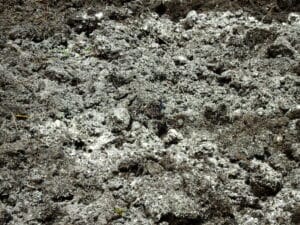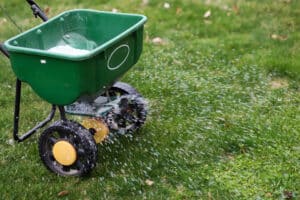Lawn fertilizer acts like food for your grass, providing essential nutrients such as nitrogen, phosphorus, and potassium to help your lawn grow thicker, healthier, and greener. But timing your fertilizer application is crucial. Fertilizing at the wrong time of year can encourage excessive top growth at the expense of root development, leading to weak, thin grass.
When caring for your lawn, the two most important factors to consider are your grass type and climate. Cool-season grasses such as Kentucky bluegrass and fescues thrive in northern climates and grow best in spring and fall. Warm-season grasses such as Bermudagrass and zoysiagrass thrive in southern climates and grow best in summer. Matching your fertilizer schedule to your grass type and climate will promote optimal growth without stressing your grass.
This guide explains exactly when and how often you should fertilize your lawn to suit your yard’s specific needs. Check out our list of the best lawn care providers once you’re ready for fertilization services.
Find Lawn Help
- See our list of top lawn care companies based on in-depth research.
- Select the company that best meets your needs.
- Get a free, no-obligation quote for your home.
Get a Quote From Lawn Professionals Near You
Compare quotes from local pros
Clicking “Get Your Estimate” submits your data to Home Service Quotes, which will process your data in accordance with the Home Service Quotes Privacy Policy.

Lime Soil Amendment

Lawn Fertilization
What Is the Best Time To Fertilize a Lawn?
The right time to fertilize your lawn depends on your lawn timeline, climate, and grass type. Much of the U.S. has either cool-season or warm-season grass, with some areas combining the two types for a more versatile lawn. It’s important to identify your grass type and plan your lawn care schedule around its needs. Below is a quick overview of which seasons are best for fertilization based on your lawn type.
Spring
Early spring is a great time to give your cool-season grasses a bit of a boost before going into the warmer months. This treatment should go down with a spreader before temperatures start to peak and the grass goes dormant. Cool-season grasses such as perennial ryegrass, fine fescue, tall fescue, Kentucky bluegrass, and other turfgrasses need a small amount of nitrogen-rich fertilizer to get them through summer.
If you have warm-season grass such as centipede grass, St. Augustine grass, and zoysia grass, you’ll also want to fertilize your lawn in late spring or early summer before high temperatures roll in. This helps the grass fill out and gain strength during its peak growing period.
Summer
As mentioned, warm-season grasses can be fertilized in early summer before the onset of high temperatures. Additionally, a second round of fertilizer should be applied in late summer as the heat starts to dissipate, preparing it for the cooler months ahead. Specialized slow-release granular fertilizers can be used to sustain your warm-season grass throughout the season without requiring a reapplication.
Fall
While a spring application is important for cool-season grasses, a heavy fall application is also critical to promote healthy lawn growth during peak months. Additionally, a fall fertilizer helps other grass types recover from the draining summer heat, repairing any brown spots in your lawn.
Winter
Most grasses go dormant during the winter, making fertilizer ineffective. However, some parts of the U.S. have mild winters that allow warm-season grasses to break dormancy in late winter. You can fertilize your grass to give it recovery nutrients from its winter dormancy. You’ll know it’s time if daily temperatures persist in the 70s.
How Often Should You Fertilize Your Lawn?
Just like the time of year, the frequency with which you fertilize depends on your climate and the type of grass you have. You’ll generally want to fertilize your grass during its peak growing season, which is during the fall for cool-season grasses and spring for warm-season grasses.
While one application may be enough, follow the instructions listed on your specific fertilizer for more detailed information. Some fertilizers recommend an application every eight weeks, while others suggest just a few times per season.
- Regardless of your application preference, it’s important to avoid overfertilizing, which can damage your grass’s root system and lead to poor drainage.
How Does Weather Impact Fertilizer Application?
No matter which type of fertilizer you use, don’t apply it during periods of drought or heavy rainfall. Many fertilizers need multiple waterings to soak into the soil, so applying them during a drought leaves your grass vulnerable to surface burns and slow growth. Additionally, many areas have watering restrictions during seasonal drought periods, so you’ll be unable to water your grass manually.
Periods of heavy rainfall can cause your lawn to become waterlogged, eroding soil and harming your grass. Applying fertilizer won’t be effective during this time, as water runoff can carry the fertilizer away and prevent it from receiving proper nutrients.
When Is the Best Time of Year to Fertilize Your Lawn?
Fertilizing grass is an important step in your lawn care routine as it promotes healthy root growth and keeps your lawn lush and green. However, it’s important to pick the right fertilizer for the job and apply it at the right time.
If you have cool-season grass, fertilize it briefly in the spring before a more thorough application in the fall. For warm-season grasses, fertilize frequently during the spring as directed on the bag. If you’re unsure how to properly treat your lawn, there are many lawn care fertilizer providers to help tailor a plan for your yard’s unique needs.
Common Mistakes To Avoid When Fertilizing Your Lawn
Proper fertilization ensures lush, healthy grass, but mistakes can lead to wasted effort, money, and even a damaged lawn. Here are some key errors to watch for:
- Applying fertilizer unevenly: Apply fertilizer at a consistent pace to avoid skips or overlaps.
- Applying too much nitrogen: Too much nitrogen during the growing season, especially for warm-season grasses, can weaken grass and increase disease susceptibility.
- Fertilizing before heavy rain: Check the weather beforehand—a large storm can wash away your fertilizer and its effects.
- Misreading instructions: Many fertilizers have unique instructions on how to avoid nutrient overload, so ensure that you follow them correctly.
- Missing pre-fertilization prep: Mow the lawn before fertilizing, allowing all nutrients to reach the soil and roots.
- Misusing fast-release fertilizers: Use fertilizers with fast-releasing nitrogen when the weather is under 85 degrees to avoid burning your grass.
Our Conclusion
Fertilizing your lawn at the right time and with the proper technique rejuvenates your grass. By understanding your grass type, monitoring the weather, and following a regular schedule, you can maintain a healthy, vibrant lawn throughout the year. Whether you grow cool-season or warm-season grass, aligning your fertilizer routine with its natural growth cycle produces the best results.
Avoiding common mistakes also plays a major role in your lawn’s health maintenance. Follow the fertilizer’s instructions, prepare your yard before each application, and never guess when it comes to timing or quantity. With the right approach, your lawn can grow strong roots, resist weeds, and stay green from season to season.
FAQs About Lawn Fertilization
How do I know when to fertilize my lawn?
You’ll know when to fertilize your lawn for most grass types when the soil reaches 55 degrees Fahrenheit. This can be measured by a soil thermometer or by monitoring the blossoming of springtime plants such as lilacs. This is around mid-April for most of the U.S.
Do I fertilize my lawn before or after rain?
You should fertilize your lawn a day or so after a light rain so the soil is damp and ready to receive nutrients. Do not apply fertilizer before or after heavy rains.
When is the best time to fertilize my lawn?
The exact timing depends on the type of grass you have and the climate you live in. You’ll also want to water your lawn one to three days before fertilization and try to avoid rain in the weather forecast for a few days afterward. Homeowners with cool-season grasses have a lawn fertilizer schedule that begins in the fall, while those with warm-season grasses schedule it for the spring.
What is the difference between organic and synthetic fertilizer?
The difference between organic and synthetic fertilizers can be found in the sources from which they’re made. Organic fertilizer has been extracted from living organisms such as plant- or animal-derived products and organic waste. By contrast, synthetic fertilizers are made with minerals such as nitrogen, phosphorus, and potassium along with inorganic waste materials.
Can I use grass clippings as fertilizer?
Yes, grass clippings are excellent to use as fertilizer. Leave your clippings in the grass after mowing to help reduce the amount of nitrogen fertilizer used throughout your yard. Grass clippings can provide many of the nutrients your lawn needs.






